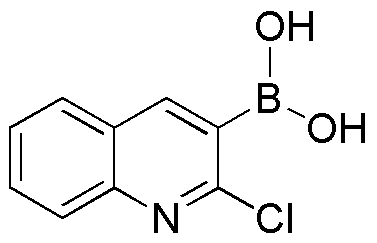2-Chloroquinoline-3-boronic acid is widely utilized in research focused on:
- Pharmaceutical Development: This compound serves as a key building block in the synthesis of various pharmaceutical agents, particularly those targeting cancer and infectious diseases.
- Organic Synthesis: It is employed in cross-coupling reactions, which are essential for creating complex organic molecules, making it valuable in the development of new materials and chemicals.
- Bioconjugation: The unique properties of this boronic acid facilitate the attachment of biomolecules, enhancing drug delivery systems and improving the efficacy of therapeutic agents.
- Fluorescent Probes: Researchers utilize this compound in the creation of fluorescent probes for biological imaging, allowing for real-time tracking of cellular processes.
- Environmental Applications: It is also being explored for use in the detection and removal of pollutants, showcasing its potential in environmental chemistry and sustainability efforts.
General Information
Properties
Safety and Regulations
Applications
2-Chloroquinoline-3-boronic acid is widely utilized in research focused on:
- Pharmaceutical Development: This compound serves as a key building block in the synthesis of various pharmaceutical agents, particularly those targeting cancer and infectious diseases.
- Organic Synthesis: It is employed in cross-coupling reactions, which are essential for creating complex organic molecules, making it valuable in the development of new materials and chemicals.
- Bioconjugation: The unique properties of this boronic acid facilitate the attachment of biomolecules, enhancing drug delivery systems and improving the efficacy of therapeutic agents.
- Fluorescent Probes: Researchers utilize this compound in the creation of fluorescent probes for biological imaging, allowing for real-time tracking of cellular processes.
- Environmental Applications: It is also being explored for use in the detection and removal of pollutants, showcasing its potential in environmental chemistry and sustainability efforts.
Documents
Safety Data Sheets (SDS)
The SDS provides comprehensive safety information on handling, storage, and disposal of the product.
Product Specification (PS)
The PS provides a comprehensive breakdown of the product’s properties, including chemical composition, physical state, purity, and storage requirements. It also details acceptable quality ranges and the product's intended applications.
Certificates of Analysis (COA)
Search for Certificates of Analysis (COA) by entering the products Lot Number. Lot and Batch Numbers can be found on a product’s label following the words ‘Lot’ or ‘Batch’.
Numéro de catalogue
Numéro de lot/série
Certificates Of Origin (COO)
This COO confirms the country where the product was manufactured, and also details the materials and components used in it and whether it is derived from natural, synthetic, or other specific sources. This certificate may be required for customs, trade, and regulatory compliance.
Numéro de catalogue
Numéro de lot/série
Safety Data Sheets (SDS)
The SDS provides comprehensive safety information on handling, storage, and disposal of the product.
DownloadProduct Specification (PS)
The PS provides a comprehensive breakdown of the product’s properties, including chemical composition, physical state, purity, and storage requirements. It also details acceptable quality ranges and the product's intended applications.
DownloadCertificates of Analysis (COA)
Search for Certificates of Analysis (COA) by entering the products Lot Number. Lot and Batch Numbers can be found on a product’s label following the words ‘Lot’ or ‘Batch’.
Numéro de catalogue
Numéro de lot/série
Certificates Of Origin (COO)
This COO confirms the country where the product was manufactured, and also details the materials and components used in it and whether it is derived from natural, synthetic, or other specific sources. This certificate may be required for customs, trade, and regulatory compliance.


